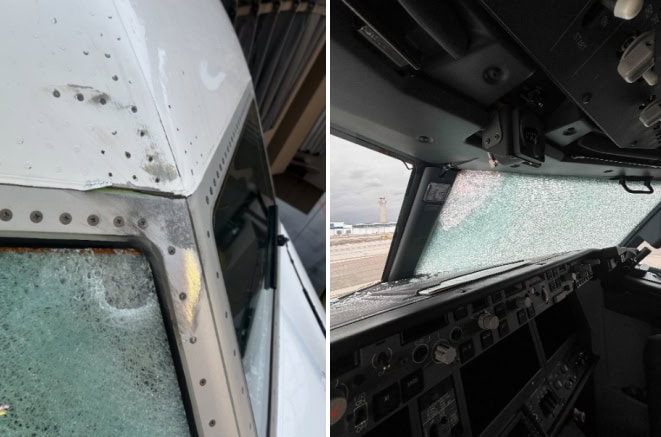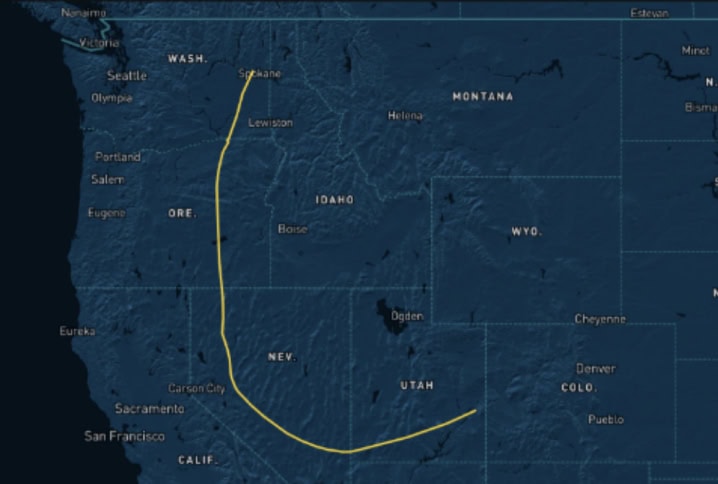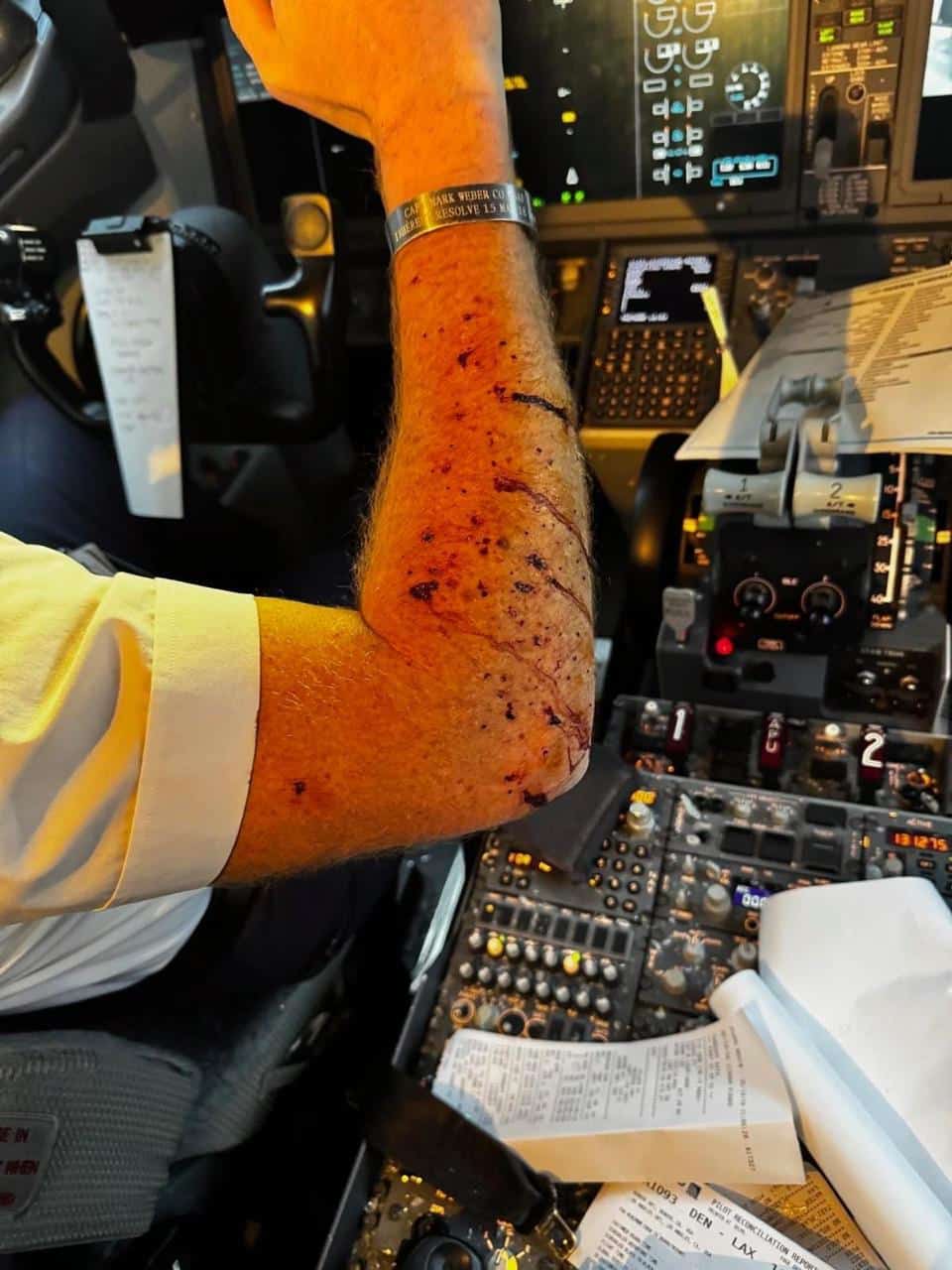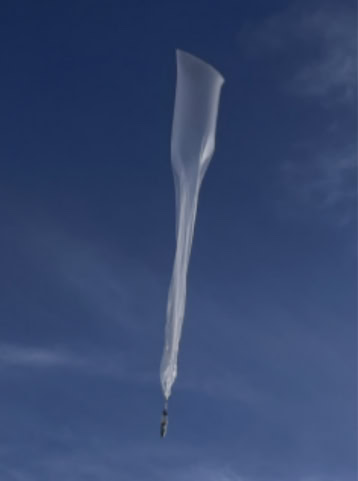New NTSB Report Reveals What Likely Happened to United Flight 1093 Over Utah
United Flight 1093 was cruising high above Utah’s Colorado Plateau region, near Moab, when the morning calm was shattered by a surprise and violent impact.
At 0643 MDT on 16 October 2025, the Boeing 737 MAX 8 (reg. N17327) was cruising at 36,000 feet on a scheduled flight between Denver International Airport (DEN) and Los Angeles International Airport (LAX) when the captain spotted something out on the horizon. It was distant. It was small. And before he could point it out, the object struck the first officer’s (FO) forward windshield with a sharp bang that echoed through the flight deck.
Both pilots were blasted with fragments of glass. The captain received “multiple superficial lacerations” on his right arm. The FO was uninjured. All 111 passengers were safe.
What hit them immediately sparked intense media speculation. It became instant fodder for armchair aviation experts on social media within hours of the accident.
Now the NTSB’s preliminary report gives us the clearest picture yet of what played out inside the cockpit and what was drifting through the sky that morning. And new information from WindBorne Systems, the operator of the balloon that was in the area at the exact moment of the strike, shows how the company is already changing its operations.
A Calm Cruise Turns Chaotic
United Flight 1093 had just crossed into Utah airspace when the object hit the FO’s windshield. The outboard layer was destroyed. Glass sprayed across the cockpit. The crew kept their composure.
The captain handed flying duties to the FO and moved into checklist mode. Cabin pressurization held steady throughout the event. The crew contacted dispatch, notified the flight attendants, and began preparing to divert the aircraft to the most suitable diversion airport. In this case, it was Salt Lake City International Airport (SLC), about 30 minutes and 160 nautical miles to the northwest of 1093’s location.
Then another complication. The FO’s window overheat light illuminated. The crew worked the appropriate checklist and continued the descent toward SLC without further incident.
The captain cleaned and bandaged his own wounds, briefed the cabin, and then took back the controls for the approach and landing.
Despite everything that had just happened, the landing on SLC’s Runway 16L was textbook. The MAX rolled to the gate under its own power with fire crews in escort. Paramedics treated the captain on arrival. No one else on board was hurt.
But the mystery was just beginning.
Something Was Up There
Once on the ground, investigators began matching the time and location of the strike with any objects that might have been in the area. Aircraft. Weather balloons. Even reentry debris.
One lead stood out almost immediately.
A WindBorne Systems global sounding balloon (GSB) had been drifting across the region that morning. It had been launched from Spokane, Washington, at 1129 MDT the morning before and had floated from Washington through Oregon and Nevada. By the time United 1093 approached Moab, the balloon had changed direction and was crossing Utah.
Most importantly, it stopped communicating with the ground within the same seven-minute window as the impact.
Its last reported altitude was 35,936 feet. United 1093 was at 36,002 feet. They were on nearly reciprocal tracks. That balloon’s last coordinates placed it less than one degree from the estimated strike location.
WindBorne says the balloon was operating legally under Part 101 as an unmanned free balloon. Their platforms are built with thin plastic film, a lightweight avionics package, and small silica ballast that is designed to break up without causing harm. No large metal structure. No rigid components.
Even so, the timing is hard to ignore.
The NTSB has not identified the object. But the report makes the proximity and altitude match practically undeniable.
And, in Windborne’s defense, its CEO, John Dean, publicly speculated that the collision could have been the fault of one of its GSBs. The company has been transparent and cooperative throughout the entire investigation.
A Hard Hit for a Tough Windshield

United’s 737 was fitted with a PPG Aerospace windshield manufactured in March 2023. Like all modern transport category windscreens, it was built to handle a four-pound bird strike without penetration and to maintain cabin pressure even if one pane fails.
The 737’s windshield uses multiple layers.
From the outside in, the structure includes:
- A thermally tempered glass outer pane
- A conductive heating film
- A urethane interlayer
- A vinyl fail-safe interlayer
- Another structural tempered glass pane
- And a stainless steel Z-bar frame encased in a moisture seal to attach it to the fuselage
On 1093, the outer pane was destroyed. Multiple layers behind it were damaged. Rivets along the frame were sheared. The inner structural glass held exactly as it was designed to, which is why the cabin stayed pressurized and the airplane remained flyable.

Had the object fully penetrated the windshield, the outcome could have been very different.
The NTSB removed the entire assembly and sent it to Washington for forensic analysis. They also pulled the flight data and cockpit voice recorders, which confirmed the flight’s heading, altitude, and speed at the moment of impact. The MAX was tracking southwest at 233 degrees at a groundspeed of 395 knots.
WindBorne Responds With New Safety Measures

Shortly after the NTSB released its preliminary report, WindBorne provided updated information on the steps it has already taken. The company confirmed that it has cooperated fully with investigators and will continue to do so.
WindBorne said its flight systems are built to prevent midair impacts and to reduce risk in the rare event something goes wrong. The company also expressed relief that United Flight 1093 landed safely with only a single minor injury and limited aircraft damage.
WindBorne has already implemented four new safety enhancements across its operations.
Reduced Exposure in Commercial Airspace: WindBorne balloons will no longer maintain superpressure neutral buoyancy inside the primary commercial altitude bands between FL300 and FL400. This change cuts balloon exposure within that altitude range by roughly 50 percent fleetwide.
Enhanced Air Traffic Coordination: In addition to the live dashboard available to air traffic organizations, WindBorne now provides automated email reports every two hours for balloons operating within a given airspace. Alerts are also generated when a balloon enters or exits that region.
Active Collision Avoidance Development: WindBorne has integrated live global ADS-B data to identify potential conflicts. The detection system is active now, and automated avoidance algorithms are currently being tested and are expected to be deployed soon.
Payload Geometry and Mass Optimization: The company is refining its payload design to further reduce cross-sectional density and impact energy. This includes evaluating lower-density ballast materials and reducing overall payload mass.
WindBorne says it has always aimed to exceed Part 101 safety standards for high altitude balloon systems. The UA1093 incident reinforced the need for continuous improvement, and the company says these changes were implemented immediately to strengthen safeguards.
The Investigation is Ongoing

The NTSB assigned specialists in materials engineering, aircraft performance, meteorology, operations, air traffic control, and both recorders. The FAA, Boeing, United, and WindBorne are participating parties.
One detail worth noting: The NTSB did not travel to the scene. This is a Class 3 investigation, which is typical for an event involving substantial damage, an injury, and an unresolved midair collision that did not result in loss of the aircraft.
The investigation is ongoing. The final report will determine what actually struck United Flight 1093 and whether any procedural or regulatory changes are recommended.
As for the aircraft involved in the incident, N17327, it was ferried to Chicago Rockford International Airport (RFD) on 19 October 2025, where it has been undergoing repairs since.
WHAT WE KNOW SO FAR:
Here is the clearest picture the preliminary report gives us:
- United Flight 1093 collided with something at 36,000 feet
- The cockpit was showered with glass
- Only the captain was injured
- The airplane remained pressurized
- The crew diverted safely to Salt Lake City International Airport
- A high-altitude weather balloon was in the same place at the same moment
- That balloon lost contact during the exact timeframe of the strike
- No other aircraft or reentry objects matched the location
- The aircraft involved in the collision, N17327, remains out of service
Nothing is confirmed yet. But the pieces are lining up.
Whatever hit United Flight 1093 did real damage. The pictures of the shattered windshield make that clear. But the inner pane held. The crew handled the emergency with textbook discipline. The airplane did what it was engineered to do.
Most importantly, every single person on board United Flight 1093 walked away from it.
Now, the NTSB will continue examining the evidence from the window, the recorders, and the flight paths of both the MAX and the balloon.
If it is confirmed to be a weather balloon, which the early clues strongly indicate, the real focus becomes understanding how it happened and what needs to change so it never happens again.
View the full NTSB Preliminary Report here:




